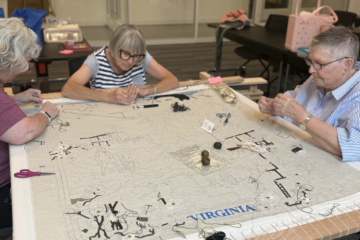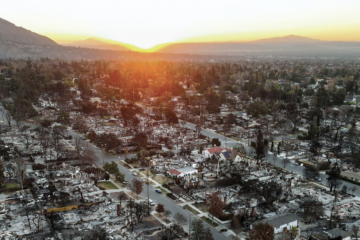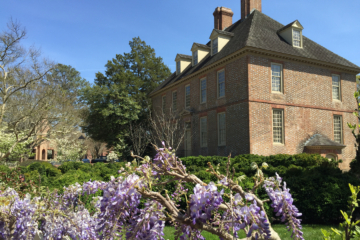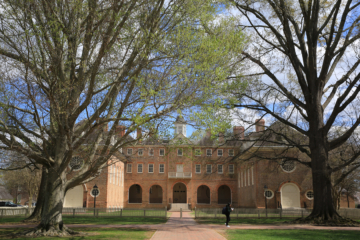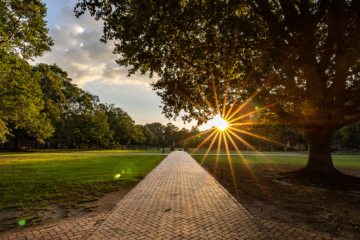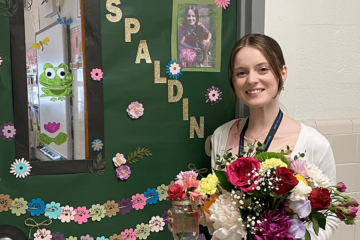America’s Tapestry project underway at the Muscarelle Museum of Art
Thousands of tiny stitches have been set, with many thousands left to go, on a collaborative tapestry now in progress at the Muscarelle Museum of Art at William & Mary’s Martha Wren Briggs Center for the Visual Arts.
The project, America’s Tapestry, marks the 250th anniversary of the nation’s founding through the creation of 13 original tapestries designed to tell a unified story of the nation.
Virginia’s segment of the tapestry, now being stitched at the Muscarelle, will join panels from the other 12 original colonies in an exhibition, scheduled to premiere at the museum in June 2026 before touring each colony. Each panel highlights a story specific to that state’s history and involvement in the American Revolution, bringing forth the lesser-known heroes of this pivotal moment in American history.

The Embroiders Guild of America (EGA) has been pivotal in driving this project into communities. This organization strives to encourage and preserve the art of needlework, along with a high standard of design and technical skills. They have a host of chapters across the country that host projects and opportunities for members to expand and share their knowledge of stitching, serving as a bureau of embroidery education. Each week, EGA members from the Rose and Thistle Chapter come into the Muscarelle and dedicate hours of their time to America’s Tapestry.
The project was guided to the Muscarelle Museum of Art by Strategic Cultural Partnerships, under the leadership of Ann Marie Stock, presidential liaison for Strategic Cultural Partnerships.
“As we approach commemorations of the 250th anniversary of the signing of the Declaration of Independence, William & Mary is leading the way in innovative programming to mark the occasion,” Stock said. “America’s Tapestry at the Muscarelle is a perfect example of leveraging William & Mary’s unique cultural resources in service of our city, our Commonwealth and our nation.”
The project’s founder, 27-year-old Stefan Romero, set out on a journey two years ago to tell the story of the birth of the United States through needlework and tapestry. Romero was first exposed to textiles at the age of seven, and from there went on to pursue his passion for textiles and design at Carnegie Mellon University. where he specialized in dress and textiles of Colonial America. Romero pursued his master’s degree at the University of Glasgow in Scotland, where he is currently based, to connect and deepen his understanding of this art.
“There are so many stories that move and inspire — from the individuals we don’t see but are important to the freedoms we have today,” Romero said.
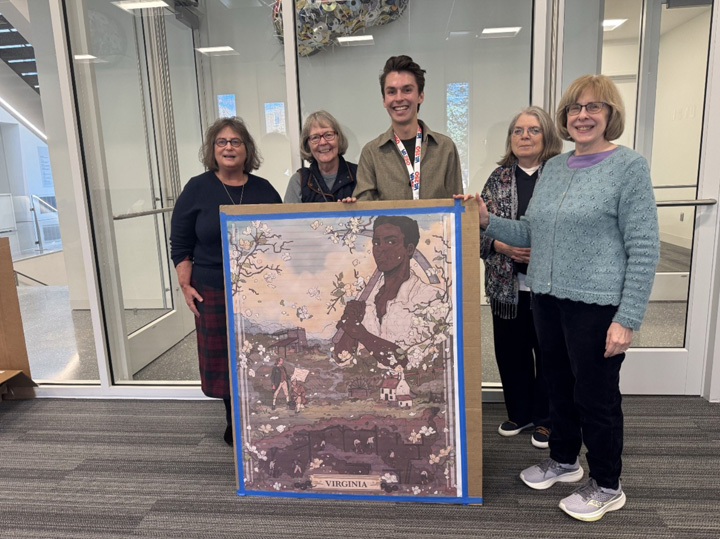
He first conceived the idea for America’s Tapestry after visiting The Great Tapestry of Scotland. There, he saw the country’s complex story unfold from panel to panel. As a result of this storytelling, he envisioned America’s own story told through separate pieces, unified in a testament of needlework, shared history and community.
When discussing the start of this endeavor, Romero explained, “I was interested in how fabric could create stories, and how costumes could tell the stories of the time that they were worn. … Needle art and embroidery is something I was unfamiliar with. … I reached out to the Embroiders Guild of America, where I learned about the vibrant community chapters in the United States, who were willing to give information and resources about the art of needlework.”
Romero also contacted institutions all over the East Coast to house Tapestry’s display, choosing locations with vibrant stitching communities, deep historical ties and in the case of Williamsburg, a thriving population of students to engage with the project.
“I reached out to William & Mary very early on.” Romero stated, “They took it upon themselves to see the vision I had and took a chance on the project and fully supported me throughout the process.”
Virginia’s panel tells the story of the lead mines in Wythe County, Virginia, that provided musket balls for the Continental Army. Composed of enslaved, convicted and imported labor, the mining community was a melting pot of people who were forced to work in dangerous, dark conditions.
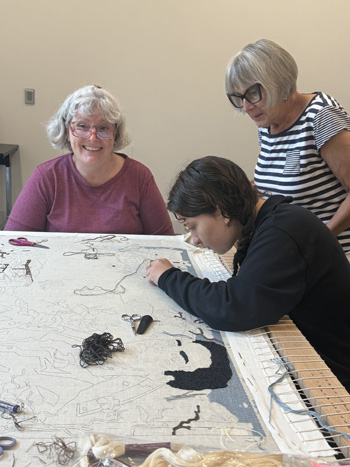
Additionally, an enslaved man by the name of Aberdeen stands proudly in the panel. After working seven long years in the mine, Aberdeen defied his Loyalist master’s orders to join the British cause and voluntarily enlisted with the Continental Army, who later granted him freedom. Untold stories such as this are being stitched from New Hampshire all the way to Georgia.
Catherine Theron is the past president of the Williamsburg chapter of the Embroiderers’ Guild of America and is acting as the state director of the Virginia panel.
“Stefan blindly wrote to me about the project,” she shared. “I started asking questions and reaching out to other stitching groups to get people excited. … Williamsburg is the perfect place — the colonial capital of America.”
At the Muscarelle, the stitchers work in a room attached to the main atrium. They welcome anyone interested in learning about the project or adding a few stitches, no matter their level of experience with needlework. Interested onlookers can step into the room with these volunteers, who dedicate hundreds of hours to learn and contribute to this region-wide project.
“We’re willing to teach,” Theron said, “People come in with no experience. We have fabrics and threading materials to practice with. Stitching should be for everybody.”
Within just an hour of talking with the volunteers, individuals can understand the secrets of sewing, like the steps of the chain stitch or a French knot. There are fabrics specifically for those new to needlework, or who have yet to consider themselves stitchers, to practice with. After each session, those who contributed are encouraged to write their name in a logbook, which documents work on the tapestry panel.
“(The book) is an artifact of this time and place, a legacy product of the 250th anniversary,” Stefan stated. “It emphasizes the importance and value the stitchers bring, and honors every hand with an impact on this project — akin to signing names on the Declaration of Independence.”
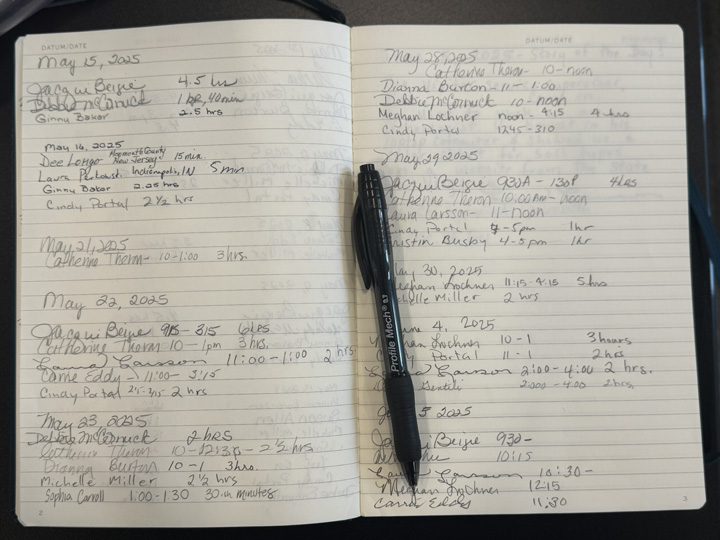
In executing the Virginia design, the volunteers can take creative liberties, making the panel unique to the volunteers. Theron discussed how the stitchers “bounce around ideas” on the stitches and thread color used to achieve different textures and dimensions.
“It took my breath away to see this diversity and artistry,” said Romero. “Many people are coming forward in the organic evolution of the project, bringing in different bags of embroidery floss, wool and silk to use on this panel. They have such faith in the project that they want to incorporate their prized materials. Thousands of hours of work go into each panel. That same level of detailed work can take five to 10 years.”
For Romero, this project was an ambitious undertaking. His plan to celebrate the 250th anniversary of the United States gave him two years to accomplish a task that might easily have taken twice the time. But a year into the project, the illustrations for the panels have been designed by young, up-and-coming artists, and twelve of the thirteen tapestries are underway. Romero overcame the obstacle of funding with a generous grant from the Coby Foundation.
“You need historians, researchers and artists,” Theron stated. “It takes time to put together. It reminds me of old quilting bees.”
This sense of community has made a profound impact on Romero. “It’s like the level of excitement if you had a pen pal for two years and then finally meet them as they are making this happen with you. It’s an incomparable feeling.”
America’s Tapestry incorporates groups of all ages, backgrounds, and interests to come together for a common goal. The project encourages and puts on full display the significance of needlework, creating history stitch by stitch.
“Stefan’s idea that there were unsung heroes reminds us that everyone plays a part,” Theron said. “There are people interested in working on this and thrilled with the message. We are finding new parts of history that American history courses don’t teach.”
“We’re honored to be hosting this important project and welcoming stitchers from across the state into the museum to work on the tapestry,” said David Brashear, director of the Muscarelle. “Once the tapestries are completed and the exhibition is assembled, we anticipate it will be a breathtaking experience for visitors — and one that will spark important conversations about the history and future of our nation.”
Latest W&M News
- Rising from the ashesThe W&M community is living with, learning from and preventing devastating wildfires.
- W&M to preserve President’s House for future generationsThe board will explore possibilities of transforming the university’s historic President's House into space that remains central to the life of the university.
- An extraordinary year for William & MaryRecord-breaking philanthropy positions William & Mary to lead.
- College of Arts & Sciences launches new name, celebrates the people of the CollegeNew name reflects a bold vision, deep roots and the people shaping the future.
- Another bumper crop of Fulbright Scholars from W&M prepares to head abroadWilliam & Mary's global reach has been confirmed once again as nine recent graduates and alumni received highly selective Fulbright Scholarships.
- Can a parasitic worm help rebuild blue crab populations in the Chesapeake Bay?A new study published in the journal PLOS One by researchers at William & Mary’s Batten School & VIMS suggests parasitic worms could serve as a valuable biomarker for managing the fishery.



